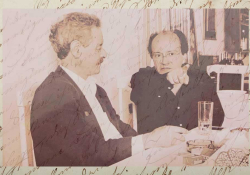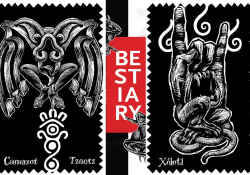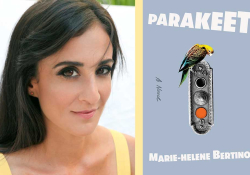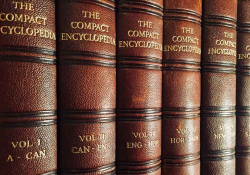My Love Affair with Don Quixote
The following essay is adapted from Quixote: The Novel and the World, due out from W.W. Norton next week.
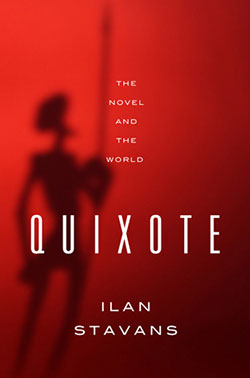 Asteroid 3552 displays some bizarre, disassociated behavior. Astronomers describe it as a small body orbiting around the sun. Yet it acts like a comet, and, for that matter, like an extinct one, meaning that the asteroid has expelled from its nucleus most of its volatile ice. Thus, it is lifeless, incapable of generating energy in its tail—a comet without force, a kind of impostor, pretending to be something it isn’t.
Asteroid 3552 displays some bizarre, disassociated behavior. Astronomers describe it as a small body orbiting around the sun. Yet it acts like a comet, and, for that matter, like an extinct one, meaning that the asteroid has expelled from its nucleus most of its volatile ice. Thus, it is lifeless, incapable of generating energy in its tail—a comet without force, a kind of impostor, pretending to be something it isn’t.
Aside from its number, astronomers have given it a name: Don Quixote. Greek myths are often used to name planets in the sky (Mars, Jupiter, Saturn . . .) as well as asteroids (Apollo, Trojan, Centaur . . .). Other such chunks of space matter also draw on inspirations from writers’ names (Franz Kafka and Kurt Vonnegut, for example) and literary characters (the moons orbiting Uranus are named after characters in Shakespeare’s plays). The asteroid known as Don Quixote was detected by Swiss astronomer Paul Wild in 1983. Measuring about nineteen kilometers in diameter (the width of San Francisco Bay), it has an inclined comet-like path, crosses the Mars orbit, and is frequently perturbed by Jupiter’s gravitational force. Its existence is tenuous: at some point, like other debris in the solar system, it might crash against the sun. But it could escape such tragic end.
In other words, Don Quixote is likely to wander forever—whatever that word means in our vast, expanding universe. Isn’t that what the real Don Quixote, the character created by Miguel de Cervantes Saavedra, does too, wandering around aimlessly in our imagination? Personally, I find it fitting to call Asteroid 3552 after what is arguably the most famous—and, in my view, the best—novelistic character of all time. He also is a kind of impostor, a migrating object faking his path through existence, an artifact passing for something he is not, dreaming of an alternative life.
We all dream of a different life. We all want to be someone else. Don Quixote is such an appealing character because he acts upon that dream. As a result, he is seen as a fool, imprisoned in his own self-made universe.
We all dream of a different life. We all want to be someone else. Don Quixote is such an appealing character because he acts upon that dream. As a result, he is seen as a fool, imprisoned in his own self-made universe. But contrary to common wisdom, foolishness isn't the antonym of reason. One can be a wise fool as well as an insane genius. Reason and foolishness—call it madness!—are actually one and the same: to be who we want to be, we need to invent a self, complete with its own logic. To be free, we need to create our own definition of liberty.
Looking back, I realize that I have spent my entire adult life wanting to be Don Quixote. Or else, imitating him all the time. I have created a self that feels appropriate, a sense of freedom I am comfortable inhabiting. I have sought to be a quixotic fool.
My admiration for Don Quixote of La Mancha has taken multiple forms. In my library, I have a large collection of Quixotalia, e.g., versions of the novel in multiple languages (from Yiddish to Korean, from Quechua to Klingon). I also have an endless assortment of adaptations, into film and theater, action figures, picture books, lunch boxes, lithographs, advertisements and postal stamps. Ironically, they all mimic a hero whose existence is spent as an impostor, pretending to be someone else.
I first discovered Don Quixote when I was in my teens, still living in Mexico where I grew up. My very first copy, a cheap Spanish-language paperback, ended up in the garbage. I must have tried reading it but found it untidy, unfocused, and monotonous—in short, impenetrable. Why keep an item you do not like? So I threw it away in the bathroom’s basket. I’m still able to see it at the bottom, amid used Q-tips, an empty toothpaste box, and Kleenex.
In 1980, I bought myself another single-volume copy (the first and second parts together in a hardcover edition). I know the exact year because I used to engrave my full name—Ilan Stavchansky—in my books, using a special metal-press seal I bought in the mail which had a code of arms I designed. Under the emblem, I signed in Hebrew and put the year.
Why such obsession to claim these copies as my own? Perhaps because of the quick, miserable death the earlier Quixote had received. Released by the publisher Bruguera in Barcelona in 1974, my embossed copy was part of the sixth printing (in Spanish printings are called editions), a handsome black cover that looks like expensive leather. It was by no means a collector’s copy, although it showed endurance: it came with me to New York when I emigrated, moving from one apartment to the next as I made my way through life.
Youth is both an illness and its cure. I was infatuated with the decaying state of the world and wanted to change it while being perfectly aware of the impracticalities of my dream.
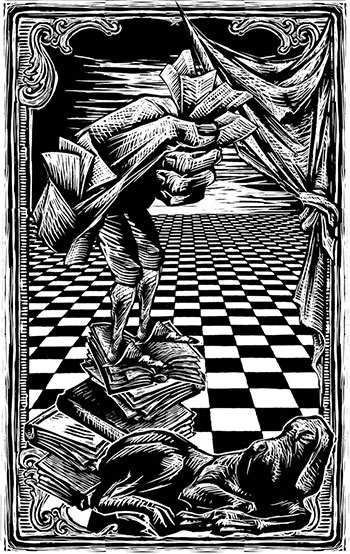
twenty original woodcut illustrations by Mexican cartoonist,
engraver, and painter Eko (b. 1958). This woodcut illustrates
the famous opening lines of the novel: “In a village of La
Mancha, the name of which I have no desire to call to mind,
there lived not long since one of those gentlemen that keep
a lance in the lance-rack, an old buckler, a lean hack, and a
greyhound for coursing.”
Youth is both an illness and its cure. I was infatuated with the decaying state of the world and wanted to change it while being perfectly aware of the impracticalities of my dream. For one thing, I wanted to one day become a writer. Writers spend their time in isolation, putting words on a page. How much more impractical might one be? Cervantes’ novel, which celebrates its 400th birthday this year (its second part was published in 1615), turns those impracticalities into a quest. Its protagonist is a nobleman around fifty years of age, who doesn’t do much except read escapist literature. Soon his brains dry up. He starts fashioning himself as a knight-errant eager to fight oppression, even though the “injustices” he encounters are imagined and his attempts to right them ineffective. Everything he does is pathetic.
That, precisely, is what I adored about the book: its vitality as well as its pathetic nature. Alonso Quijano, the hidalgo, concocts for himself a ridiculous name. He finds shining armor in the closet. He turns his skinny horse into Rocinante, a name befitting the illustrious horses of mythical stature that accompany adventurers like Amadis of Gaul and Tirant Lo Blanc. And he identifies a humble village woman, Aldonsa Lorenzo, as his beautiful and virtuous dame. His imagination alone launches him on an adventure that requires him to be courageous.
Isn’t that what we all do in life, find a purpose, a mission to justify our days? As a young man, I admired Don Quixote because of his idealism. But as I’ve returned to the book time and again, I have found other sources of inspiration. Maybe the plot isn’t really about an idealist but about a fool. After all, one doesn’t reach fifty and find nothing else to do but rectify all wrongs if insanity isn’t a part of it. As I myself have reached the age of Cervantes’ protagonist, I realize this is the story of a middle-age quest, as the body deteriorates, to retrieve the dreams we nurtured earlier in life.
Maybe the plot isn’t really about an idealist but about a fool. After all, one doesn’t reach fifty and find nothing else to do but rectify all wrongs if insanity isn’t a part of it.
In Spanish, the novel is affectionately referred to as El Quijote and I shall do the same here. The article el means the; in other words, this is it, the one and only, the novel of novels. The accolades it has received over the centuries are unparalleled. Charles Augustin Sainte-Beuve called it “the Bible of humanity.” Lionel Trilling stated that “All prose fiction is a variation on the theme of Don Quixote.” Tom Sawyer makes a reference to the enchantment at the heart of El Quijote in chapter 3 of Adventures of Huckleberry Finn.
It isn’t only widely regarded as the best novel but is also the most popular. At the dawn of the twenty-first century, the Norwegian Academy of Science and Letters asked a hundred writers from just about everywhere on the globe to name what in their estimation was the best novel. El Quijote won by a landslide: fifty respondents named it their favorite. Indeed, it is the runaway bestseller in fiction, annually selling millions of copies around the globe. Only the Bible outdoes it, but then again, the Bible isn’t written by a single author. And not all of us describe it as fiction.
Such is the magic El Quijote exerts on people that it forces us to consider what a classic is. Definitions abound: a classic is a book that defies the passing of time, or perhaps one confirming that time is never static; a book that is actually many books, as many as the number of readers it has; a book capable of shaping a nation; and a book whose obvious imperfections are kindly brushed aside in favor of its felicities, which are as substantial as they are enduring. There are other definitions of the classic I want to make: a book that is a mirror in which we see ourselves reflected, a book that accumulates interpretations, a book in which we meet readers not only from the present but also from the past and the future.
Trilling’s view that “All prose fiction is a variation on the theme of Don Quixote” rotates around the fact that the novel as a genre makes an attempt at verisimilitude—the likeness or semblance of a narrative to reality—and, in El Quijote, that verisimilitude is at once a triumph and a defeat because Cervantes delivers the adventures of madman who thinks he isn’t actually mad. Indeed, everyone has a theory about what makes Cervantes’ book tick. Some argue the novel is a psychiatric treatise in disguise. Others suggest it is a celebration of reason. The arguments have even been made that the novel is a cautionary tale against the excesses of religion and that Don Quixote is a doppelgänger of Jesus Christ. Furthermore, there are commentators who describe Cervantes’ approach to his characters as bullying, not to say condescending, whereas an army of defenders portray that approach as utterly humane.
The novel argues that reality is a concoction, that what we see isn’t there but what we want to see. Therefore, it is said that Cervantes legitimized subjectivity, that he endorsed a world where truth is no longer absolute. It has also been argued that Cervantes’ magnum opus gave traction to the Enlightenment, that it begat modernity. Without it, Borges argued, “our world wouldn’t be truly ours.”
Amherst, Massachusetts
Editorial note: The 400th anniversary edition of Cervantes’s timeless novel, with an introduction by Ilan Stavans and translated by John Ormsby, is the lead title in a new series called Restless Classics. It will be published on October 6 in deluxe paperback and ebook formats.

